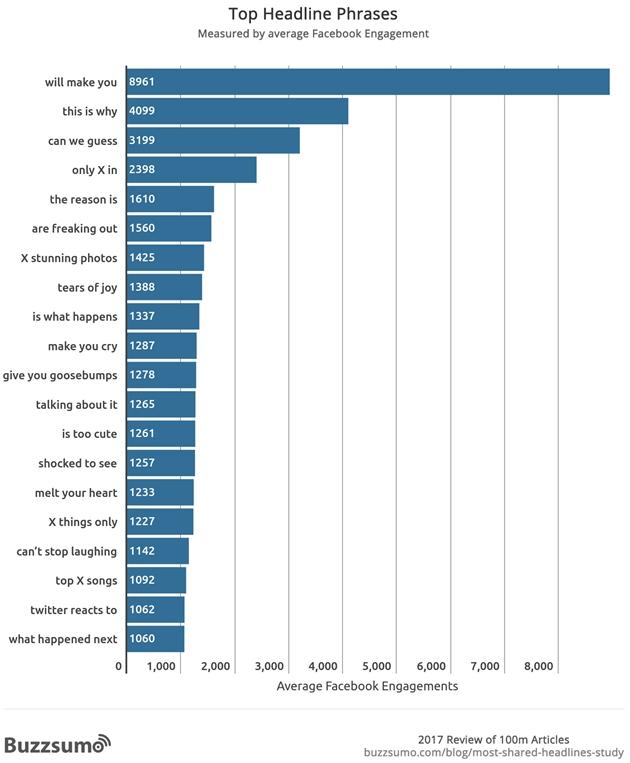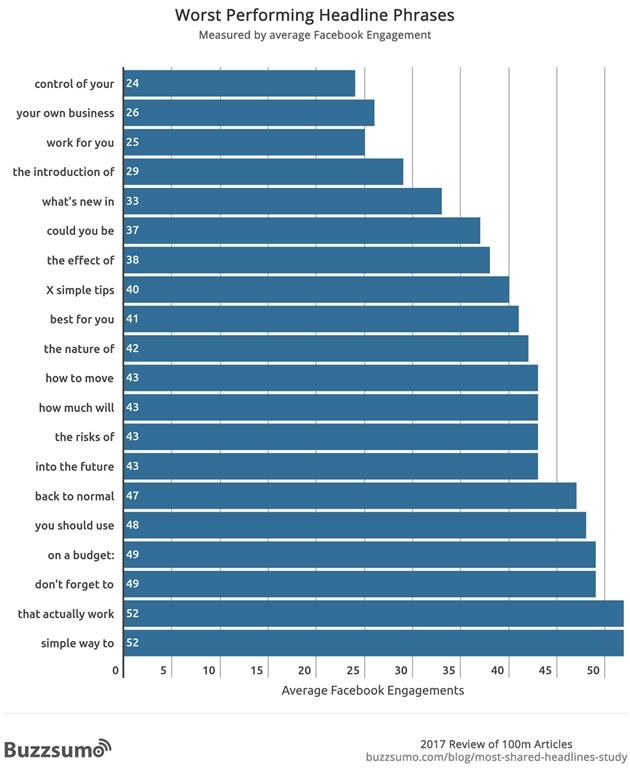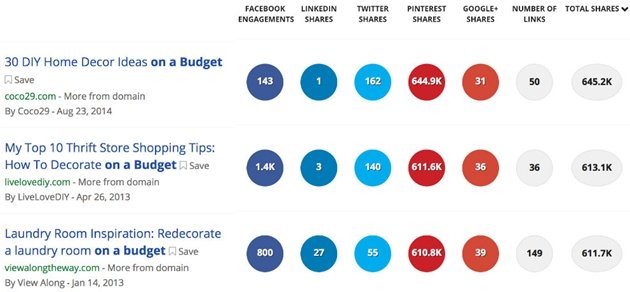What is the secret to an engaging headline?
Everyone has an opinion... but what does the data say?
At BuzzSumo, we analyzed 100 million headlines published in 2017 to see what insights, if any, we could gain to improve our headlines and ensure they resonate with our audience.
We published our detailed findings in a lengthy, 4,000-word post. But the essence of an engaging headline comes down to just a few core principles, we found.
The Data: The Most-Engaging Facebook Headline Phrases
Our research found that the three-word phrases (trigrams) that gained the most Facebook engagements—likes, shares, comments—were the following:

The Implications: The Essence of an Engaging Headline
The danger of this type of research is that people simply copy or reuse top phrases that have worked previously. I know it is tempting, but at least avoid "will make you"; I already feel bad that the research unleashed dozens of these headlines on the world in the few days after the publication of the research.
The true value of the research lies in helping us to understand the formats and principles that underpin a good headline.
The research suggests that engaging headlines...
- Focus on why the reader should care
- Have clarity and promise
- Include emotional hooks
- Provoke curiosity
- Provide explanations
- Appeal to a tribe
Let's look at these in a little more detail.
1. Make the Reader Care
In our sample, the most powerful three-word phrase used in a headline was will make you.
Linking phrases such as "will make you" can be an elegant and effective way of connecting your content to the reader and why they should care.
This format makes explicit the linkage between the content and the potential impact on the reader.
For example: "8 Habits That Will Make You More Productive"
The other key feature of "will make you" headlines is the promise: There is a clear promise that the content will make you productive or happy or sad or... Which brings us to the next principle.
2. Clarity and Promise
Readers like to know what they will get when clicking through to your post. I think this is why list posts work well. The reader knows exactly what they are going to get...
For example: "10 Pictures That Show What Pollution Has Done to Delhi"
This form of headline has clarity and a promise; in this case, you will see the effects of pollution in 10 pictures.
The nature of the promise can be more expansive, however.
For example: "27 Amazing Charts That Will Turn You Into a Baking Whiz"
Of course, the content must live up the promise; otherwise, your credibility will be shot. In this case, I really don't think any charts will make me a baking whiz, but I was probably not the target audience. Over 900,000 people shared this post. (We will talk more about the importance of the audience later.)
3. Emotional Hooks
In consumer content, we were not surprised to find that emotional words and phrases have impact. Well-shared headlines included phrases such as the following:
- Tears of joy
- Make you cry
- Melt your heart
- Most beautiful
- Can't stop laughing
These emotional headlines were used far less in B2B headlines, and they didn't appear in the top trigrams for LinkedIn or Twitter.
However, certain keywords can have a similar emotional impact in B2B headlines. For example, words such as "success" or "successful" in a LinkedIn headline typically get a lot more shares than the average.
4. Curiosity
Curiosity is powerful. There are some things we can't resist. It is part of that classic narrative arc of an unfolding mystery: We want to find out "who did it."
I am disappointed to report that "what happened next" was a top phrase that plays on our curiosity. Clickbait headlines containing that phrase typically show disrespect to the reader, and they are far removed from the traditional journalistic practice of summarizing the important details in the headline. On the positive side, Facebook now categorizes headlines that withhold information as clickbait, and demotes them.
There are ways to provoke curiosity in your headlines without resorting to "what happened next" clickbait.
5. Explanations
"This is why" was the No. 2 best-performing phrase in our sample of 100 million posts. Explanation posts can use headlines to provoke curiosity as well as provide answers. For example:
- "This Is Why You Should Never Drink Water With Ice"
- "This Is Why You Should Be Sleeping On Your Left Side"
Explanations backed by research or science appear to do particularly well. A whole new "genre" of "science says" and "according to science" posts has emerged recently.
6. Tribalism
One of the unfortunate things about recent political developments has been the increased tribalism in politics, which has in turn led to more polemical headlines that are widely shared by supporters of one political viewpoint or another.
People widely share content to show they are part of a tribe and to support their tribe.
This sort of tribalism extends well beyond politics. Headlines and content designed to appeal to a specific group of people can frequently benefit from tribal loyalty. For example:
- "25 Things Only Teachers Will Understand"
- "Science Says the First Born Child Is the Most Intelligent"
- "10 Must Read Books for Marketing Professionals"
Learning From the Phrases That Fail to Engage
We also looked at the commonly used phrases in headlines that receive the lowest Facebook engagement. In some ways, this exercise was more insightful than the top engaging phrases.

Note: We looked only at phrases or trigrams that were used on a minimum of 100 domains. Accordingly, there are clearly worse-performing phrases; but these are the worst-performing commonly used phrases.
My sense of these phrases is that they are typically more negative in tone. For example, among these phrases are "the risks of," "don't forget to" and "how much will."
The Importance of Context
It was interesting to see how poorly phrases some phrases, such as "on a budget," performed on Facebook. That may be due to the context: On Facebook, people are looking for more inspirational or amusing content than practical content.
By contrast, the phrase "on a budget" appears to work well on Pinterest for DIY topics, because the context is different. See these examples:

Context, then, is important: Phrases that work well in one context may work far less well in another, the research found.
For example, we found that in the health category "need to know" was a powerful phrase. However, in a marketing context, it can be far less effective, such as a post on "10 Things You Need to Know About BuzzSumo." The health context is what gives the phrase personal impact.
The Secret to Engaging Headlines? Understanding Context and Research
Our research may provoke many ideas about headline words and phrases, but it has more value in drawing out the fundamental characteristics of engaging headlines. To repeat, they typically include one or more of the following:
- A focus on why the reader should care
- Clarity and promise
- Emotional hooks
- Provoke curiosity
- Provide explanations
- Appeal to a tribe
The research also reinforces the importance of context and emphasizes why you need to research what works in your specific context: namely, your audience, your industry, your topics, and your social networks.




